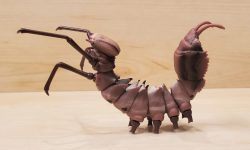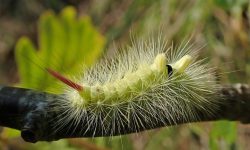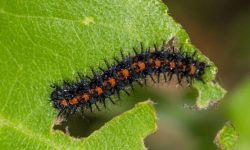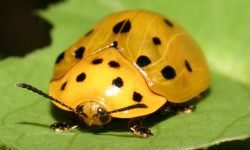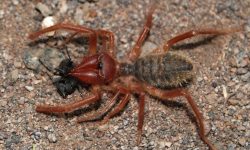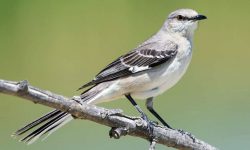There are about eighteen different types of red bugs with black spots that exhibit different patterns and characteristics. Red bugs are a common sight in the natural world. These insects exhibit a wide range of forms, sizes, and patterns. Their vivid red bodies are dotted with contrasting black dots. A thorough grasp can be attained by looking through the intricate images of these 18 different variations, which offer a perceptive look into the intriguing world of these remarkable animals.
Different Types of Red Bugs with Black Spots
Red and Black Blister Beetle (Meloidae)
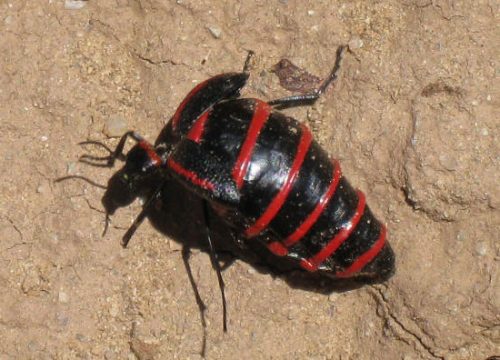
The Red and Black Blister Beetle, part of the Meloidae family, displays a bright red body adorned with fine-haired black spots. Notably, the Mylabris quadripunctata species features a slender physique with two rows of black dots and tail markings, along with a small black thorax and head. Ranging from 0.4” to 0.8” (10 – 20 mm) in length, these beetles primarily consume insects, eggs, and vegetation, their toxic secretion capable of causing skin irritation and blisters. Identification involves recognizing their bright red bodies, multiple black spots, six black legs, and clubbed antennae.
Desert Blister Beetle (Lytta magister)
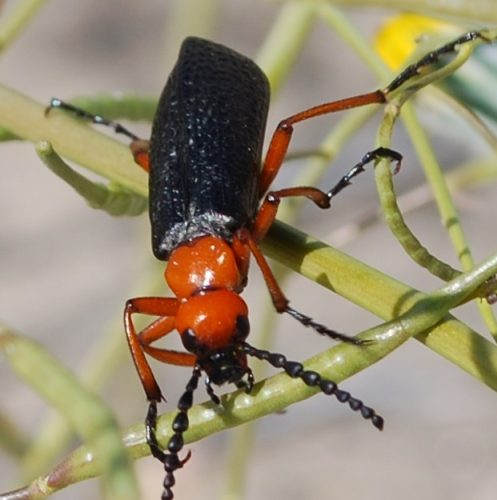
The Desert Blister Beetle, scientifically known as Lytta magister, showcases a black body, contrasting with a striking red head, red legs, and filiform antennae. Found commonly in California and the southwestern United States, these large beetles can measure between 0.6” and 1.3” (16 – 33 mm). They primarily feed on brittlebush flowers but are also known to bite. Similar to other blister beetles, their yellowish, malodorous secretion can induce painful skin blisters. Distinguishing features include the deep black body, glossy red head, red legs, and filiform-shaped antennae.
Cocklebur Weevil (Rhodobaenus quinquepunctatus)
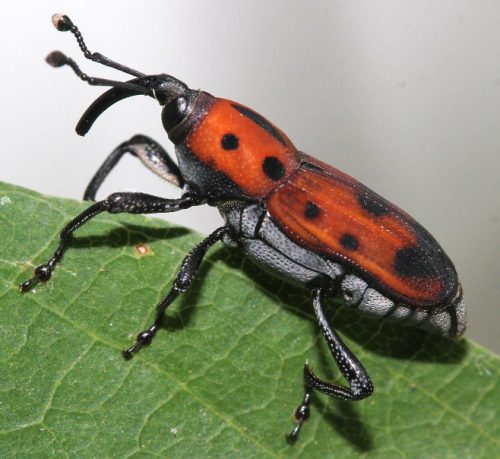
The Cocklebur Weevil, or Rhodobaenus quinquepunctatus, boasts a red and black appearance with a characteristic black rounded snout, typical of weevils. Its orange-red body and thorax, along with a small black head, are complemented by distinctive black spots on its back. These weevils, measuring 0.25” to 0.5” (6 – 13 mm) in length, typically consume cocklebur, ragweed, or thistle leaves. Also known as the “five-spotted billbug,” variations in black dots may occur on other red and black weevil species. Identification is facilitated by its dark orange to red body, black spots, legs, elongated black snout, and jointed geniculate antennae.
Boxelder Bug (Boisea trivittata)
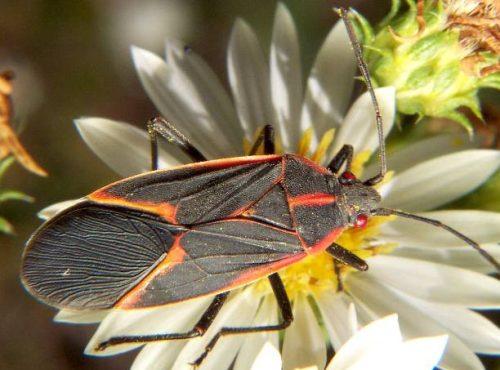
The Boxelder Bug, or Boisea trivittata, is a prevalent flying insect with a flattened, elongated oval body featuring red or orange lines. Measuring 0.5” (13 mm), it frequents maples, boxelder trees, ash trees, and strawberries from spring through fall. Though non-threatening, these bugs can be bothersome when they infiltrate homes through cracks or open windows in summer. Simple preventive measures like window screens and sealing cracks can deter their entry. Despite their classification as “scentless plant bugs,” they emit a strong odor when crushed. To remove them from house exteriors, using insecticidal soap or hot soapy water is effective. The boxelder bug can be recognized by its orange-red markings on its wings and back, along with its dark gray or black body.
Red-Shouldered Bug (Jadera haematoloma)
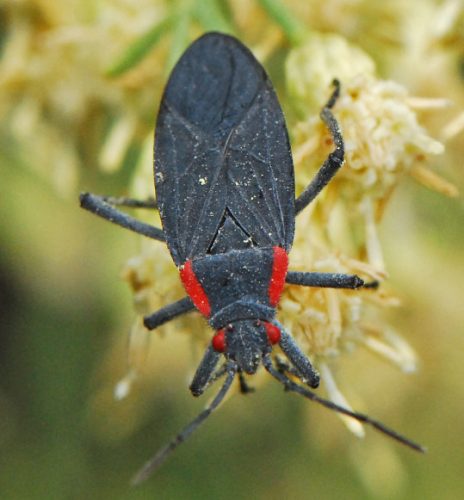
The Black Body of the Red-Shouldered Bug (Jadera haematoloma), also called the Soapberry Bug, is adorned with bright red markings on its shoulders and wing edges. This insect, which has bright red eyes, is about 0.5″ (13 mm) long and has an oval shape that has been flattened. Notably, like boxelder bug nymphs, its nymphs have a black head and a bright red body. These tiny insects, which are frequently found in Florida gardens, mostly consume the leaves and stems of their hosts. Their red markings help to differentiate them from boxelder bugs, which they resemble. If you crush them, your clothes might get reddish stains. Look for an elongated oval body with vivid red colors on the shoulders and body edges to identify a red-shouldered bug.
Milkweed Assassin Bug (Zelus longipes)
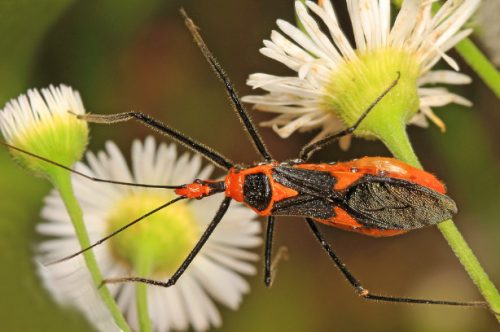
The scientific name for the Milkweed Assassin Bug is Zelus longipes. It has a bright red body with black patterns on it, along with six long black legs and two wings. This thin insect has an oval abdomen that is elongated, a long mouthpart that it uses for sucking, and white markings on its underside. Small, about 0.5″ (20 mm) long, these insects are helpful predators that feed on harmful beetles, flies, caterpillars, and mosquitoes. Although they are not hostile, if they feel threatened, they can bite. Their jet black hairy legs, long black antennae, elongated piercing mouthpiece, bright red and black pattern, and slender body are some of their distinguishing characteristics.
Firebug (Pyrrhocoris apterus)
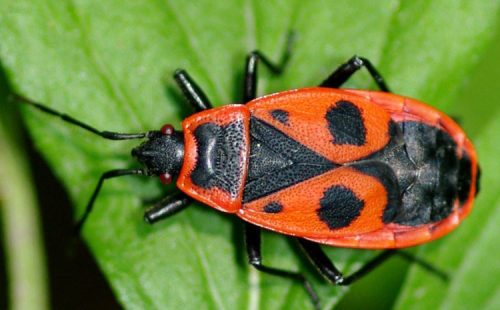
The Firebug, or Pyrrhocoris apterus, is a distinctive garden dweller, sporting a small red body adorned with black round spots and triangular markings. Measuring 0.4” (10 mm) in length, it commonly feeds on lime and mallow trees. While not harmful to humans or trees, their intrusion into homes during fall can be bothersome. Crushing them releases an unpleasant odor, potentially attracting other insects, while their red color can stain clothing and carpets. Easily identified by their red oval bodies, marked with two black dots and triangles, they also feature black legs and antennae. Vacuuming is an effective method for their removal from indoor spaces.
Mediterranean Red Bug (Scantius aegyptius)
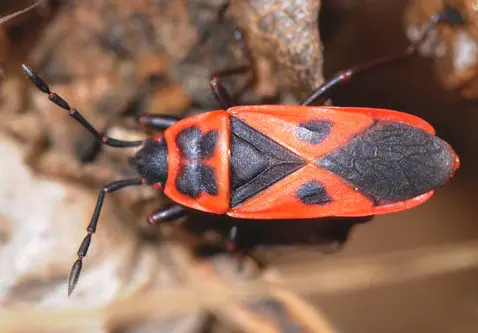
The Mediterranean Red Bug, or Scantius aegyptius, boasts a vibrant orange-red body adorned with striking black markings, often leading to confusion with the firebug. Measuring between 0.27” to 0.35” (7 – 9 mm), this invasive bug is prevalent in California. In its juvenile stage, it appears entirely red, gradually developing black spots as it matures. Distinguishing features include two black spots and a notable black hourglass marking on its elongated red-orange body.
Bee Assassin Bug (Apiomerus crassipes)
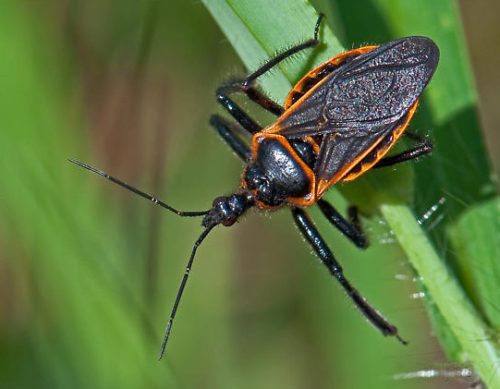
The Apiomerus crassipes, or Bee Assassin Bug, has a black body with characteristic red markings running down its abdomen. These flying insects, which are easily identified by their triangular shape, six black legs, and thin, wiry antennae, actively hunt wasps and bees as they move from plant to plant. The adult bee assassin is a common species in North America. Its length ranges from 0.55″ to 0.78″ (14 to 20 mm), and it usually inhabits pine trees. Distinguished by a black body that has been flattened and has reddish or orange edges, as well as strong, hairy legs and thin antennae.
Italian Striped Bug (Graphosoma italicum)
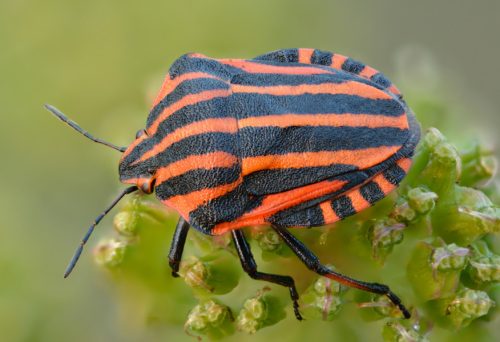
Graphosoma italicum, commonly referred to as the minstrel bug or Italian Striped Bug, is a black insect with a characteristic shield-shaped body and eye-catching orange-reddish stripes. Its length ranges from 0.31 to 0.47 inches (8 to 12 mm), and it usually feeds on Apiaceae plants such as hogweed, parsley, carrot, and celery. The red and black stripes on the bug alert potential predators. This bug is easily identified by its round, shield-shaped body, which is mostly red with thick, longitudinal black stripes.
Two-Spotted Stink Bug (Cosmopepla conspicillaris)
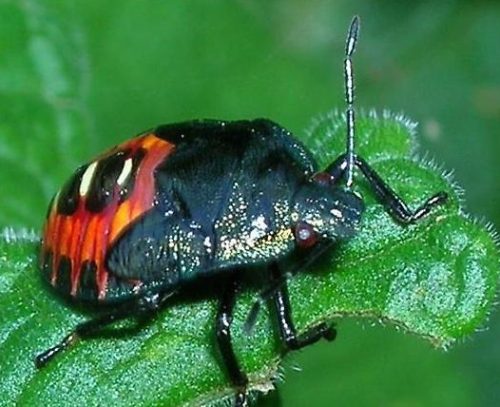
The Two-Spotted Stink Bug, or Cosmopepla conspicillaris, has a distinctive appearance. Its shiny black body is accented with thin orange lines around its edges and an orange-red band close to its head. Its underside is streaked with black and has yellow colors. Its name, “happy bespectacled stink bug,” alludes to its markings resembling spectacles and the red or yellow semicircle on its back that resembles a smile. Its length is approximately 0.3″ (8 mm). Notable for its eye-catching orange-red band that resembles colorful spectacles, this bug also has thin antennae, yellow markings on its belly, and a bright pattern in the shape of a U on its back.
Red and Black Ladybugs (Coccinellidae)
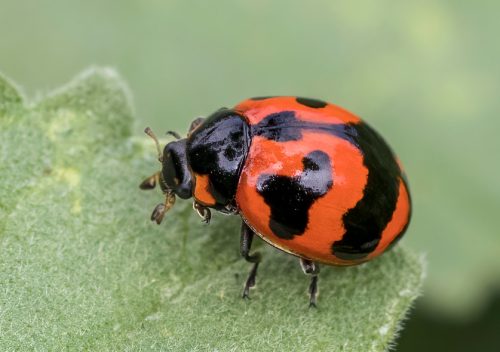
Red and Black Ladybugs, members of the Coccinellidae family, are identifiable by their distinctive rounded red wing coverings adorned with black spots. Ranging from 0.04” to 0.4” (1 – 10 mm) in length, these winged bugs often migrate indoors during the autumn. It’s worth noting that some variations of ladybugs feature a yellow and black color scheme.
Asian Lady Beetle (Harmonia axyridis)
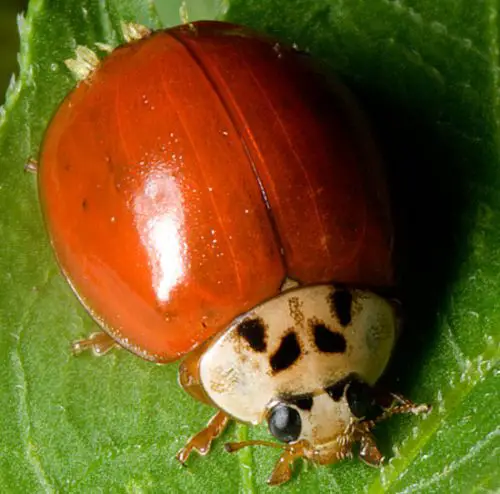
Depending on the species, the Asian lady beetle, also known as Harmonia axyridis, has black bodies with red spots or red bodies with black dots. It is an invasive species in North America. These flying insects, which are between 0.2 and 0.3 inches (5 and 8 mm) long, resemble natural ladybugs but are infamous for biting and causing allergic skin reactions.
Black Clock Beetle (Pterostichus madidus)
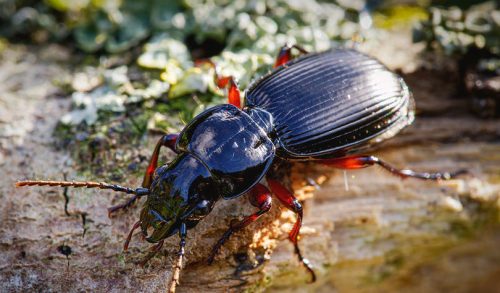
Pterostichus madidus, also known as the Black Clock Beetle, has a striking red body with black legs that are covered in spines. Its glossy black abdomen is ridged in a noticeable way. This beetle, which ranges in length from 0.55″ to 0.78″ (14–20 mm), is frequently found in gardens.
Scarlet Lily Leaf Beetle (Lilioceris lilii)
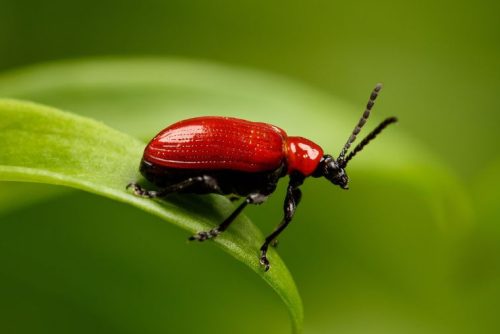
Lilioceris lilii, also known as the Scarlet Lily Leaf Beetle, is a vivid red leaf beetle with black antennae, legs, and head. This beetle, which is about ¼ to ⅜ inch (6 to 9 mm) in length, feeds on the leaves, stems, and flowers of plants in the Liliaceae family.
People Who Read This Also Read:

